1993 CHEVROLET CAVALIER seats
[x] Cancel search: seatsPage 42 of 308
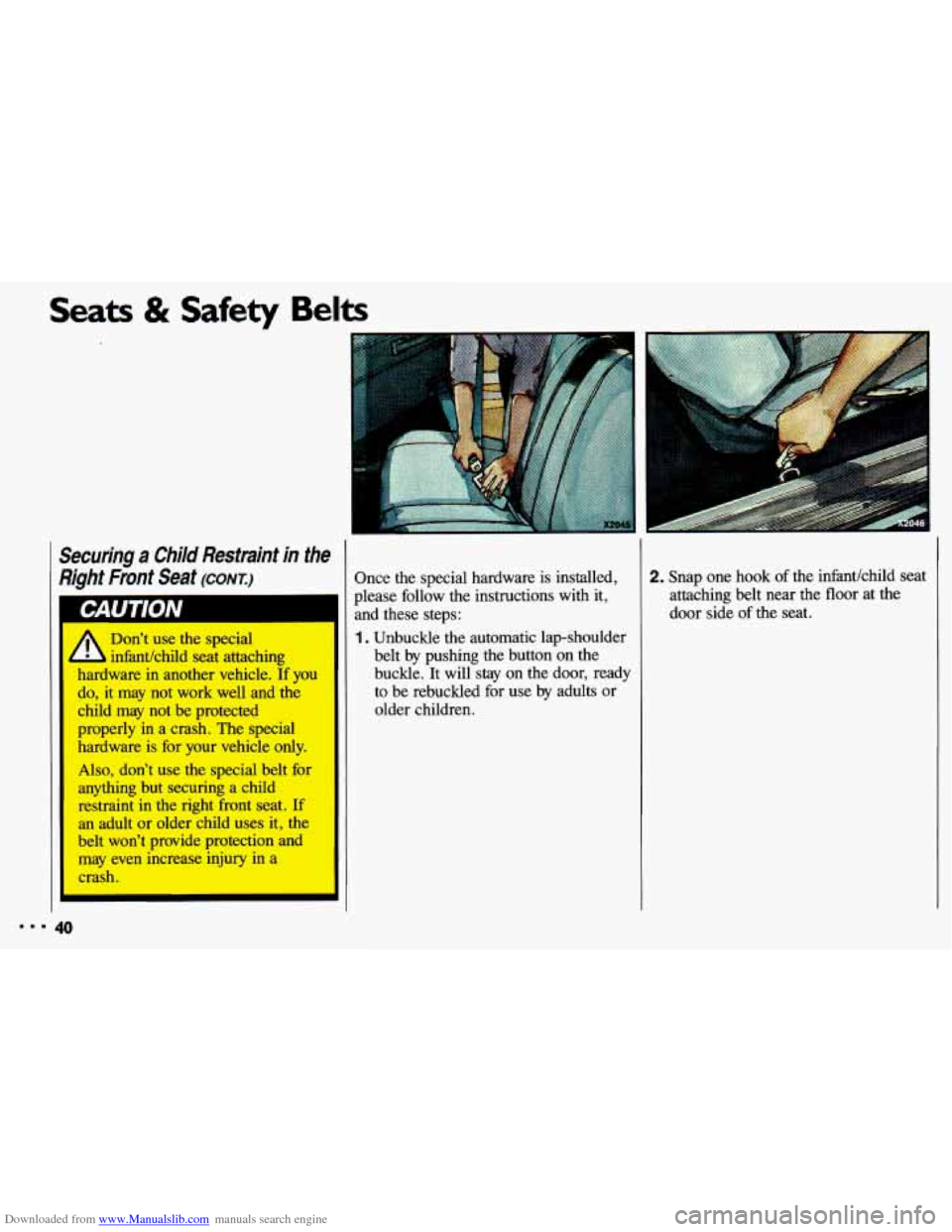
Downloaded from www.Manualslib.com manuals search engine Seats & Safety Belts
Securing a Child Restraint in the
Right Front Seat (CONT.)
yr/ infantkhild seat attaching
hardware in another vehicle.
If you
do, it may not work well and the
child may not be protected
I
properly in a crash. The special
hardware is for your vehicle only.
Also, don’t use the special belt for
anything but securing a child
restraint in the right front seat.
If
an adult or older child uses it, the
belt won’t provide protection and
may even increase injury in a
crash.
I
Once the special hardware is installed,
please follow the instructions with it,
and these steps:
1 . Unbuckle the automatic lap-shoulder
belt by pushing the button on the
buckle. It
will stay on the door, ready
to be rebuckled for use by adults or
older children.
2. Snap one hook of the infmtkhild seat
attaching belt near the
floor at the
door side
of the seat.
Page 44 of 308
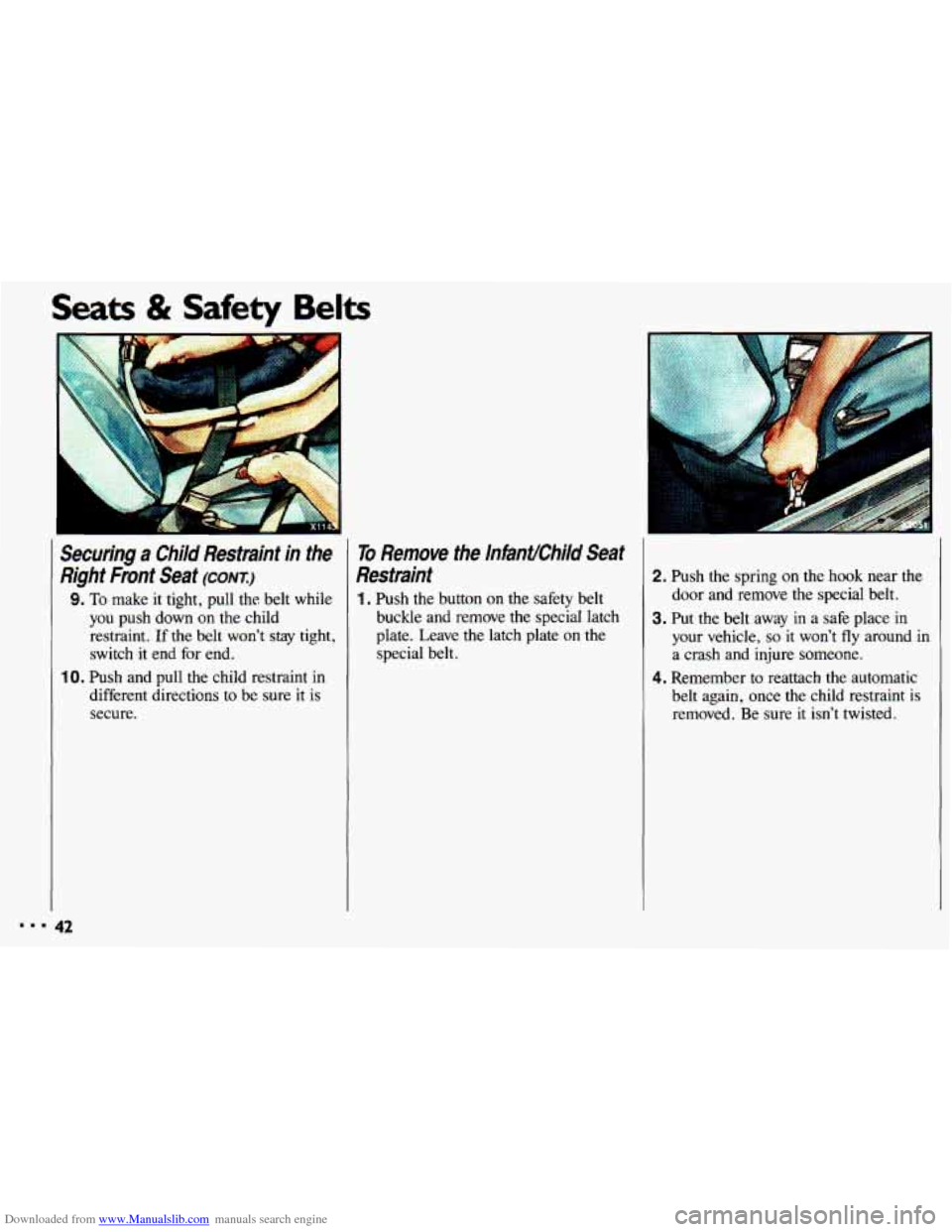
Downloaded from www.Manualslib.com manuals search engine Seats & Safety Belts
Securing a Child Restraint in the
7ight Front Seat
(CONX:)
9. To make it tight, pull the belt while
you push down on the child
restraint.
If the belt won’t stay tight,
switch
it end for end.
IO. Push and pull the child restraint in
different directions
to be sure it is
secure.
To Remove the InfanUChiId Seat
Restraint
1. Push the button on the safety belt
buckle and remove the special latch
plate. Leave the latch plate on the special belt.
2. Push the spring on the hook near the
door and remove the special belt.
3. Put the belt away in a safe place in
your vehicle, so it won’t fly around in
a crash and injure someone.
4. Remember to reattach the automatic
belt again, once the child restraint is
removed. Be sure it isn’t twisted.
Page 46 of 308

Downloaded from www.Manualslib.com manuals search engine Seats & Safety Belts
larger Children (CONT.)
Q: What if a child is wearing a lap-
shoulder belt, but the child is
so
small that the shoulder belt is very
close to the child’s face or
neck?
A: Move the child toward the center of
the vehicle, but be sure that the shoulder belt still is on the child’s
shoulder,
so that in a crash the
child‘s upper body would have the
restraint that belts provide.
If the child is
so small that the
shoulder belt is still very close to the
child’s face or neck, you might want
to place the child in the center seat
position, the one that has only a lap
belt. Here
a child is sitting in a seat
that has a lap-shoulder belt, but the
shoulder part is behind the child.
If the child wears the belt in this
way, in a crash the child might
slide under the belt. The belt’s
force would then be applied right
on the child’s abdomen. That could
cause serious or fatal injuries.
Wherever the child sits, the lap portion
of the belt should be worn low and snug
on the hips, just touching the child’s
thighs. This applies belt force to the child’s pelvic bones in a crash.
Safety Belt Extender
If the vehicle’s safety belt will fasten
around you, you should use it. The
automatic lap-shoulder belt has plenty of
extra length built in,
so it will fasten
around almost all people.
But if a safety belt isn’t long enough to
fasten, your dealer will order you
an
extender. It’s free. When you go in to
order it, take the heaviest coat you will
wear,
so the extender will be long
enough for you. The extender will be
just for you, and just for the seat in your
vehicle that you choose. Don’t let
someone else use it, and use it only for
the seat it is made to fit. To wear it, just
attach it to the regular safety belt.
Page 56 of 308

Downloaded from www.Manualslib.com manuals search engine Features & Controls
. . ,. .
. ... .
Convenience Net (OPTION)
Your vehicle may have a convenience
net. You’ll see it just inside
the back
wall of the trunk. Put small loads, like
grocery bags, behind the net. It can help
keep them from falling over during
sharp turns or quick
starts and stops.
Unclip a corner of the convenience net
to
fit larger objects behind the net, then
reclip it to secure them in place.
The
net isn’t for larger, heavier loads.
Store them in the trunk as far forward
as
you can.
You can unhook the net
so that it will lie
flat when you’re not using it.
Trunk Cargo Anchors (omoN)
If your vehicle has fold-down rear seats,
you’ll find two or four anchors on the
back wall of your trunk. You can use
these anchors to tie down lighter loads.
They prevent things from shifting during sudden stops, turns and maneuvers.
These anchors are not for heavier loads.
Store those items as far forward in
the
trunk as possible.
New Vehicle “Break-ln”
Your modern Chevrolet doesn’t
need an elaborate “break-in.” But
it will perform better in the long run
if you follow these guidelines:
Don’t drive at any one speed-
fast or slow-for the first
500
miles (804 km 3on’t make full
throttle starts.
first 200 miles (322 km) or so.
During this time your new brake
linings aren’t yet broken in.
Harc
stops with new linings can mean
premature wear and earlier replacement. Follow this
“breaking-in” guideline eveq
time
you get new brake linings.
Avoid making hard stops for 1
Page 62 of 308
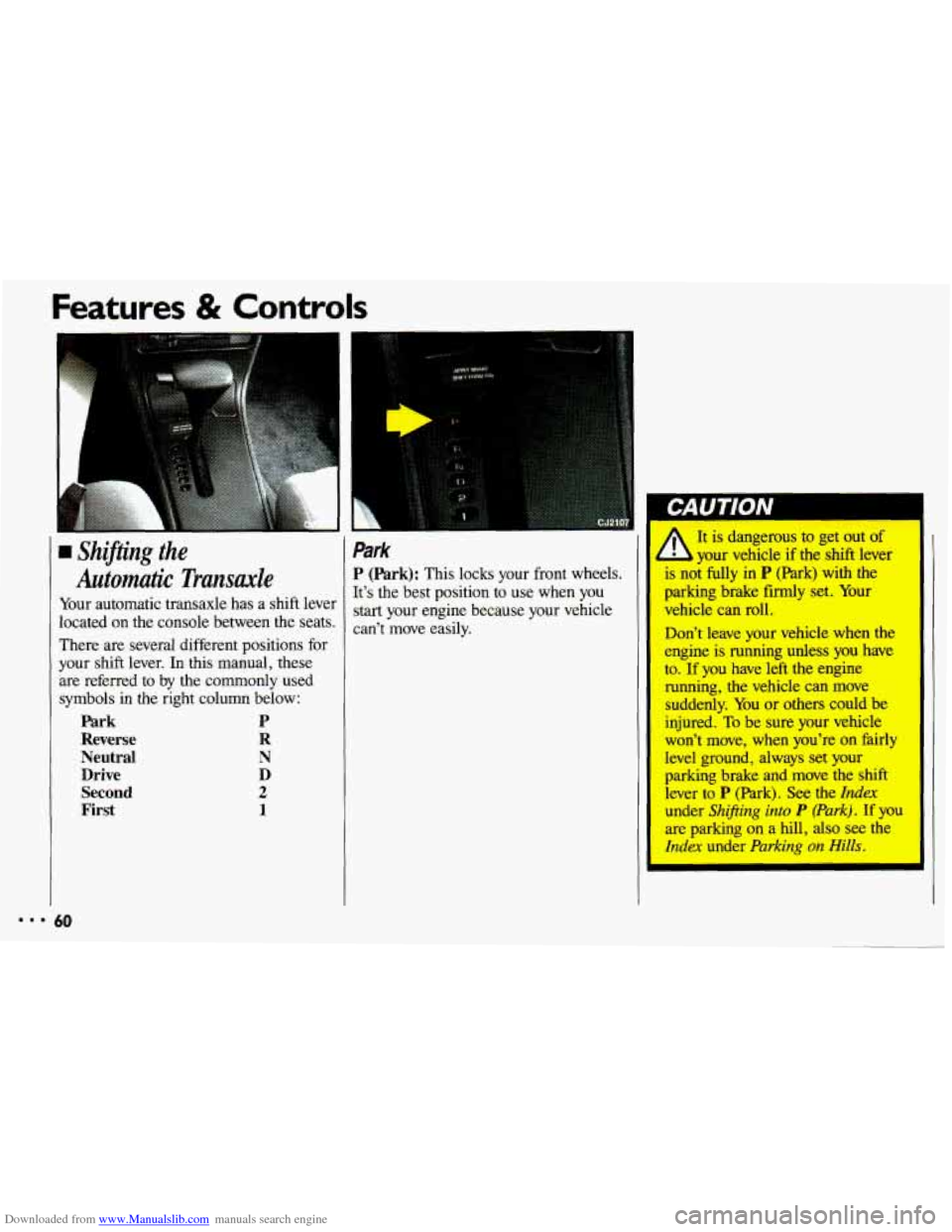
Downloaded from www.Manualslib.com manuals search engine Features & Controls
rn Shifting the
Automatic Transaxle
Your automatic transaxle has a shift lever
located
on the console between the seats.
There are several different positions for
your shift lever. In this manual, these
are referred to by the commonly used
symbols in
the right column below:
Park P
Reverse R
Neutral
N
Drive D
Second
2
First 1
Park
P (Park): This locks your front wheels.
It’s the best position to use when you
start your engine because your vehicle
can’t move easily.
I It is dangerous to get out of
your vehicle if the shift lever
is noi fully in
P (Park) with the
parking brake firmly set. Your
vehicle can roll.
Don’t leave your vehicle when the
engine is running unless
you have
to.
If you have left the engine
running, the vehicle can move
suddenly. You or others could be
injured.
To be sure your vehicle
won’t move, when you’re on fairly
level ground, always set your
parking brake and move the shift
lever to
P (Park). See the Index
under Shifting into P (Park). If you
are parking on a hill, also see the
Index under Parking on Hills.
Page 68 of 308
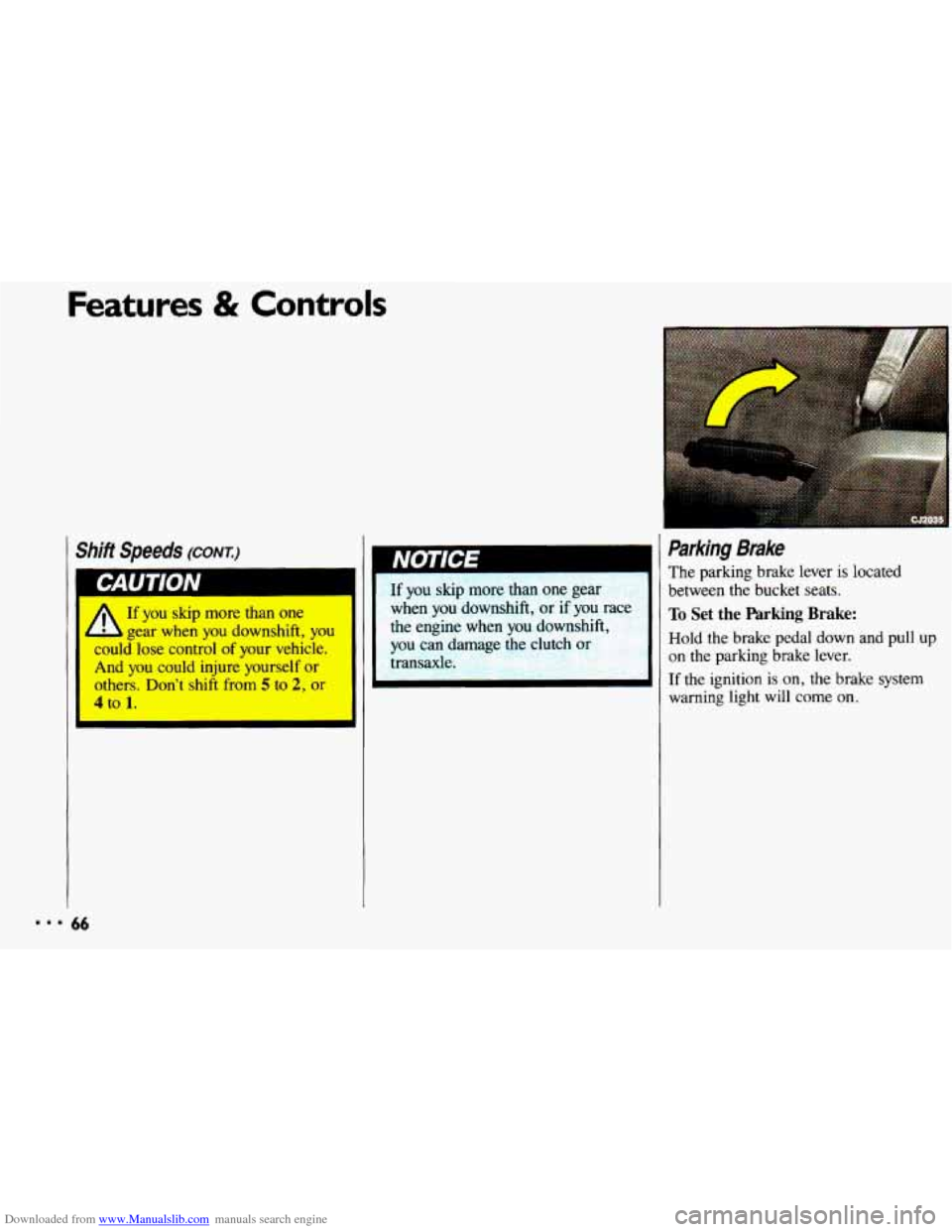
Downloaded from www.Manualslib.com manuals search engine Features & Controls
ShiiT Speeds (COPIT.)
If you skip more than one
4 1 gear when you downshift, you
could lose control of your vehicle.
And you could injure yourself
or
others. Don’t shift from 5 to 2, or
4 to 1.
I
I b
66
when you downshift, or if you
the engine when you downshift,
you
can damage the clutch or
transaxle.
i
Parking Brake
The parking brake lever is located
between
the bucket seats.
To Set the Parking Brake:
Hold the brake pedal down and pull up
on the parking brake lever.
If the ignition is on, the brake system
warning
light will come on.
Page 112 of 308
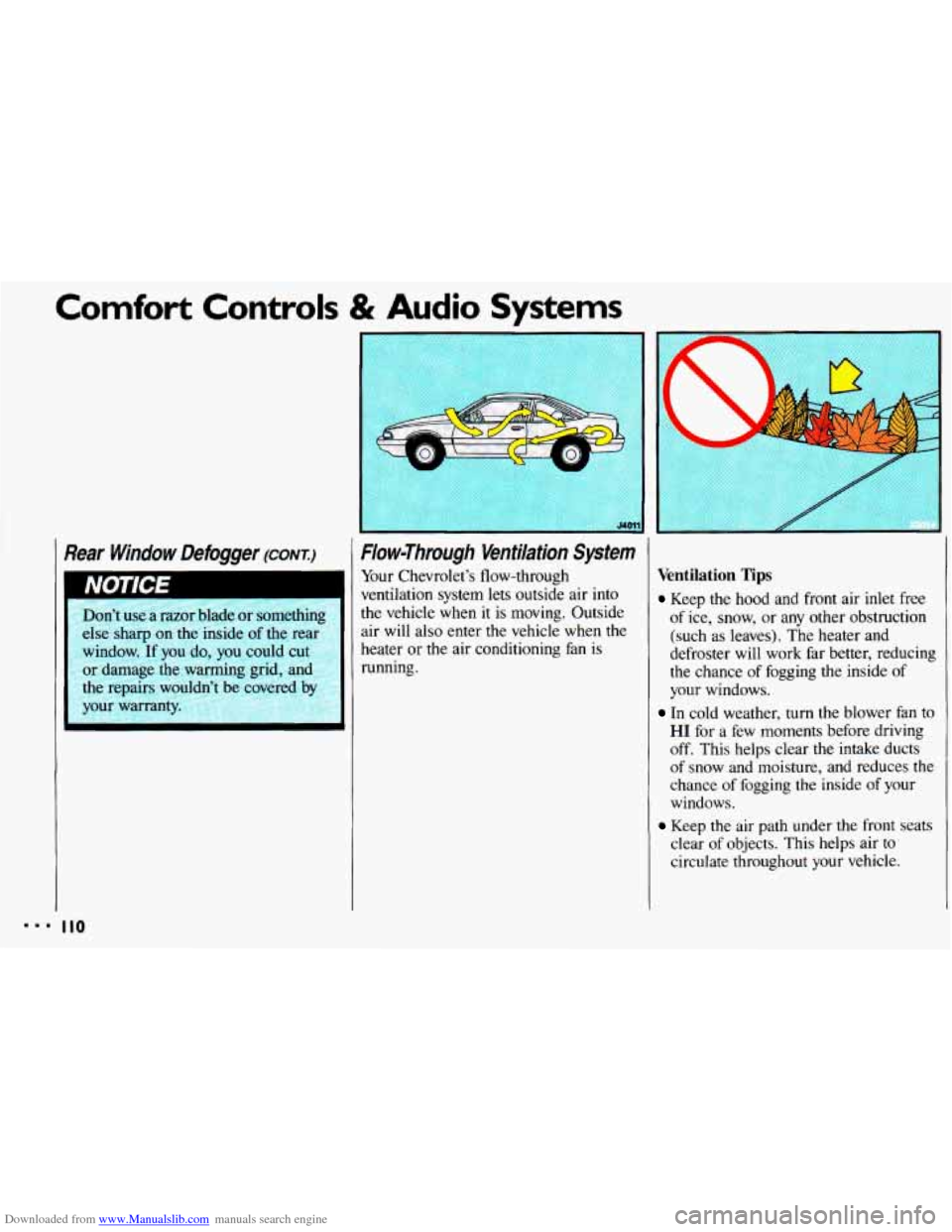
Downloaded from www.Manualslib.com manuals search engine Comfort Controls & Audio Systems
r
?ear Window Defogger (cow.)
Don’t use a razor blade or something
else sharp on the inside
of the rear
window. If you do,
you could cut
or damage
the warming grid, and
the repairs wouldn’t be covered by
your warranty.
Flow-Through Ventilation System
Your Chevrolet’s flow-through
ventilation system lets outside air into
the vehicle
when it is moving. Outside
air
will also enter the vehicle when the
heater or the air conditioning fan is
running.
Ventilation Tips
Keep the hood and front air inlet free
of ice, snow, or any other obstruction
(such as leaves). The heater and
defroster
will work far better, reducing
the chance
of fogging the inside of
your windows.
In cold weather, turn the blower fan to
HI for a few moments before driving
off.
This helps clear the intake ducts
of snow and moisture, and reduces the
chance of fogging the inside of your
windows.
Keep the air path under the front seats
clear of objects. This helps air
to
circulate throughout your vehicle.
Page 231 of 308

Downloaded from www.Manualslib.com manuals search engine 1--
-
Things you=
strike and injure
people in
a sudden stop or turn, or
in
a crash.
Put things in the trunk or rear
area
of your vehicle. In a trunk,
put them as hr forward as you
can.
Try to spread the weight
evenly.
If you have fold-down
rear seats, you’ll find four
anchors on the back wall
of your
trunk.
You can use these anchors
to tie down lighter loads. They’re
not strong enough for
heavy
things, however, so put them as
fbr forward
as you can in the
trunk or rear area.
Never stack heavier things, like
suitcases, inside the vehicle
so
that some of them are above the
tops
of the seats.
e When you carry something
inside the vehicle, secure it
whenever you can.
unless you need to.
0 Don’t leave a seat folded down
I
Tires
We don’t make tires. Your new vehicle comes with high quality tires made by a
leading tire manufacturer. These tires are warranted by the tire manufacturers and
their warranties are delivered with every
new Chevrolet. If your spare tire is a
different brand than your road tires,
you will have a tire warranty folder from each
of these manufacturers.
I I
CAUTION
Poorly maintained and improperly used tires are dangerous. 1
’ - Overloading your tires can cause overheating as a result of too much
friction. You could have
an air-out and a serious accident. See the Index
under hading Your Vehicle.
Underinflated tires pose the same danger as overloaded tires. The resulting
accident could cause serious injury. Check all tires frequently to maintain
the recommended pressure. Tire pressure should be checked
when your
tires
are cold.
sudden impact:
such as when you hit a pothole. Keep tires at the
recommended pressure.
I Overinflated tires are more likely to be cut, punctured, or broken by a
Worn, old tires can cause accidents. If your tread is badly worn, or if your
I tires have been damaged, replace them. I
229
I
I..